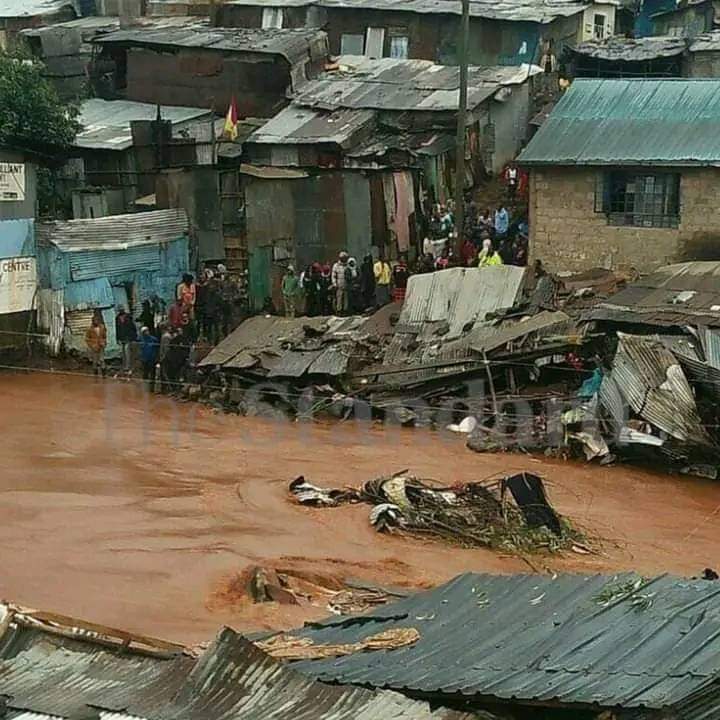The Meteorological Department has notified Nairobi residents to expect heavy to very heavy rains exceeding 40mm in 24 hours beginning Thursday.In the forecast broadcast Thursday afternoon, the weatherman said the rain is expected to persist across several regions including the Lake Victoria Basin, Rift Valley, Highlands West and East of the Rift Valley, Southeast Lowlands, Coast, and northern sector.
“The intensity is predicted to escalate, surpassing 50mm in 24hrs,” the department said and advised Kenyans to stay weather-aware and prepared.It said the heavy rains are expected to persist from Friday, April 26 through to Saturday, April 27.“Reduction in intensity is likely by April 28. Gusty winds, large Ocean waves, and strong southerly winds are likely in the eastern sector. Stay safe and vigilant,” the weatherman said.
According to the forecast, the heavy rains that will hit 100mm in some areas in Nairobi are expected in Westlands, Lang’ata, Kibra, Roysambu, Dagoreti South and Embakasi East and South.The neighbouring Kiambu is also expected to receive the rains in places like Kiambaa, Kabete, Limuru, Githunguri, Thika town, Ruiru, Juja and Gatundu North and South.
The forecast shows that the rains will spill over to Machakos and ravage areas such as Matungulu, Mavoko and Kangundo as well as Masinga, Mwala, Kathiani, Machakos town and Yatta where intensity is expected to drop slightly and oscillate between 20 to 50mm of rain.Residents of Kajiado have also been advised to stay weather aware as rains of varied intensity are expected Thursday through Friday.
The rains are expected to cause flash floods in many areas including where it may not rain considering the ground is already saturated in areas that received heavy rains Tuesday night.In Nairobi, the weather forecast predicts heavy rainfall, with the intensity expected to increase over the next 24 hours, potentially exceeding 50mm of rainfall. This forecast carries significant implications for various aspects of life in the city, ranging from transportation and infrastructure to agriculture and the environment.
The impact of heavy rainfall on transportation cannot be overstated. Nairobi, like many urban centers, is susceptible to flooding during periods of intense rainfall due to inadequate drainage systems and urban sprawl. Roads can become impassable, leading to traffic congestion and delays in commuting. Additionally, flooded streets pose a safety risk to motorists and pedestrians alike. Emergency services may struggle to reach those in need, exacerbating the challenges faced during such weather events.
Infrastructure is also vulnerable to the effects of heavy rainfall. Poorly constructed buildings may suffer water damage, while drainage systems may become overwhelmed, leading to localized flooding. This can disrupt essential services such as electricity and water supply, further compounding the challenges faced by residents. Additionally, landslides and mudslides are a concern in areas with steep terrain, posing a threat to homes and infrastructure.
Agriculture is another sector that is heavily influenced by rainfall patterns. While rain is essential for crop growth, excessive or poorly timed rainfall can lead to waterlogging, erosion, and crop damage. Farmers may struggle to plant or harvest crops during periods of heavy rainfall, affecting food production and livelihoods. Furthermore, livestock may be at risk of disease or injury in flooded or muddy conditions.
The environment also experiences both positive and negative effects from heavy rainfall. On one hand, rainfall replenishes water sources such as rivers, lakes, and reservoirs, which are crucial for ecosystems and human consumption. It also promotes plant growth and biodiversity in forests and wetlands. However, excessive runoff from urban areas can carry pollutants into waterways, leading to water contamination and degradation of aquatic habitats. Soil erosion caused by heavy rainfall can also contribute to the loss of fertile topsoil and degradation of land quality.
In addition to these immediate impacts, heavy rainfall can have long-term consequences for urban planning and development. As climate change leads to more frequent and intense weather events, cities like Nairobi must adapt their infrastructure and policies to mitigate the risks associated with heavy rainfall. This may involve investing in improved drainage systems, green infrastructure, and flood management strategies to build resilience against future storms.
Urban planners and policymakers must also consider the equitable distribution of resources and infrastructure to ensure that vulnerable communities are not disproportionately affected by extreme weather events.The forecast of heavy rainfall in Nairobi carries significant implications for various aspects of life in the city, from transportation and infrastructure to agriculture and the environment.
While rain is essential for the growth and well-being of ecosystems, excessive rainfall can lead to flooding, infrastructure damage, and disruptions to daily life. As cities continue to face the challenges of climate change, proactive measures must be taken to build resilience and adapt to the changing climate patterns.One significant concern during heavy rainfall events is the risk of waterborne diseases.
Flooding can contaminate drinking water sources with sewage, bacteria, and other pathogens, increasing the likelihood of outbreaks of diseases such as cholera, typhoid fever, and hepatitis. This poses a serious public health threat, particularly in densely populated urban areas where access to clean water and sanitation facilities may already be limited. Health authorities must be vigilant in monitoring water quality and providing timely interventions to prevent the spread of waterborne illnesses during and after heavy rainfall events.
Infrastructure damage caused by heavy rainfall can also have economic repercussions for Nairobi. Repairing roads, bridges, and other public infrastructure damaged by flooding or landslides can be costly and time-consuming. Additionally, disruptions to businesses and supply chains due to transportation delays and power outages can lead to financial losses for both businesses and individuals. Small businesses, in particular, may struggle to recover from the impact of severe weather events, further exacerbating existing socioeconomic inequalities.
Furthermore, heavy rainfall events can exacerbate existing environmental challenges in Nairobi, such as deforestation, air pollution, and habitat destruction. Urbanization and land use changes contribute to the loss of natural vegetation, reducing the ability of ecosystems to absorb and regulate rainfall. This increases the risk of flash floods, soil erosion, and landslides, further degrading the environment and endangering biodiversity. Addressing these environmental issues requires a holistic approach that considers the interconnectedness of urban development, environmental conservation, and climate resilience.
Social cohesion and community resilience are also crucial factors in mitigating the impacts of heavy rainfall in Nairobi. Strong social networks and community organizations play a vital role in disaster preparedness, response, and recovery efforts. Community-based initiatives such as early warning systems, emergency shelters, and mutual aid networks can help vulnerable communities cope with the effects of extreme weather events and reduce the risk of loss of life and property.
The forecast of heavy rainfall in Nairobi highlights the complex interplay between environmental, social, economic, and public health factors in the face of climate change. Addressing the challenges posed by heavy rainfall requires a multi-sectoral approach that integrates urban planning, infrastructure development, disaster risk reduction, and community resilience building. By investing in sustainable and climate-resilient solutions, Nairobi can better adapt to the impacts of extreme weather events and build a more resilient and sustainable future for its residents.

